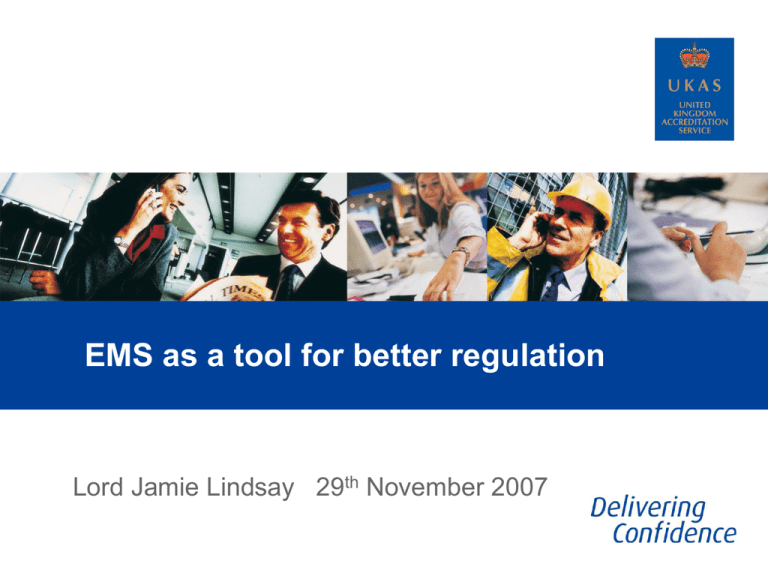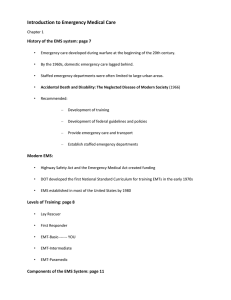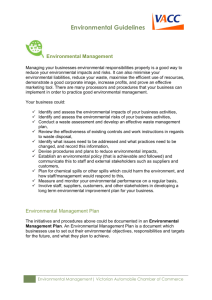Plenary - Lord Lindsay
advertisement

EMS as a tool for better regulation Lord Jamie Lindsay 29th November 2007 Better Regulation Commission To advise the Government on action to: Reduce unnecessary regulatory and administrative burdens Ensure that regulation and its enforcement are • Proportionate • Accountable • Consistent • Transparent • Targeted Avoid unintended consequences Better Regulation Commission ‘Risk Report’ Recommendations included: • Change our approach to risk • Re-target the responsibility for managing risk • Reduce the high cost of risk management • Review the stock of regulation • “leave the responsibility for managing risk with those best placed to manage it” • “embark on state regulation only where it represents the optimum solution for managing risk” • “re-examine areas where the state has assumed more responsibility for people’s lives than is healthy or desired” Objectives of better regulation • Less administrative burden • Greater focus on the ‘free-loaders’ • Legislation and regulatory activity only where necessary • Focus on the results rather than the process IN SHORT ‘MORE FOR LESS’ Objectives of better regulation Legal activities PRAGMATIC ANGELS aware unaware NEUTRAL ROGUES Illegal activities What is Accreditation? “ Formal recognition that an organisation is competent to carry out specific tasks or types of tasks” “ Impartial, independent assessment of competence against international standards” UKAS ACCREDITATION ENSURES THAT STANDARDS ARE APPLIED IMPARTIALLY CONSISTENTLY RIGOROUSLY BY COMPETENT PERSONNEL USING, WHERE APPROPRIATE, CALIBRATED EQUIPMENT AND FACILITIES Accreditation: Principal Drivers Better regulation, efficient government, public sector procurement Confidence, trust, credibility, reliability, assurance Zero Risk, Zero Liability; Good & Best practice; Quality & Well-Being Sustainability, Risk management, corporate governance & responsibility Tradability, specification, competitiveness, innovation Multi-sectoral, multi-disciplinary applications International recognition UKAS - where do we fit? Government recognition UKAS Accreditation International standards CONFORMITY ASSESSMENT (testing & calibration labs, certification & inspection bodies, or any independent evaluation) Standards/regulatory requirements/scheme criteria BUSINESS, ORGANISATIONS (people, management systems, equipment, organisations, products etc.) CONFIDENCE GOVERNMENT TRUST CONSUMERS ASSURANCE PURCHASERS UKAS underpins….. …..the credibility and robustness of a wide spectrum of standards and services, ranging across: • • • • • • • • • Environmental Management Systems Health Protection Agency Food Safety & Labelling Emissions Trading Scheme High Speed Rail Interoperability Medical Devices CORGI gas installers Building Regulations Asbestos testing & surveying Evolving EMS rigours Illust. Vilhelm Pedersen from “The emperor’s new clothes” Evolving EMS rigours UKAS – increased oversight of 3rd party EMS certification COMPLIANCE Guidance: compliance/compliance management & EA07/04 All accredited certification bodies to abide by this TRANSPARANCY 2007: IEMA requesting info for register of EMS certificates UKAS follow-up to IEMA using ISO/IEC17021 CONSISTENCY and ROBUSTNESS New UKAS requirements UKAS suspensions (information is available on the website) UKAS can accept, and will investigate, complaints from the public, regulators, industry or NGO’s regarding the performance of CBs Linking EMS and regulation 0.4 0.2 0.0 -0.2 -0.4 EMAS ISO 14001 Plus ISO 14001 (base) Informal None Linking EMS and regulation Staff Raw materials Utilities Product Manufacture or Service provision Waste materials Regulatory Effort More efficient regulation Direct Application Registrations Standard permits RISK Permits More effective regulation Source: European Space Agency, 2004-2005 Where are EMS today ? - Defra HMG statement on how EMSs can help business & the public sector reduce their environmental impacts 1. Organisations should use a robust and credible EMS that is appropriate for improving their environmental and financial performance 2. Organisations implementing an EMS should use a national or international standard or scheme 3. An EMS should be audited by an independent certifier accredited by the UKAS 4. An EMS should help improve environmental and financial performance through the supply chain. 5. An EMS that demonstrates good management of legislative compliance should be used to help achieve regulatory benefits such as reduced fees and charges Where are EMS today ? - UK • Recognition in the Environment Agency’s OPRA scheme – more for EMS that is certified by an accredited body • Sector-specific recognition: e.g. OSPAR guidance for offshore oil platforms • Licenses, Permits, Permissions, Grants • Customers, Corporate Governance, Risk, PR • Financial Sector – insurers, lenders, investors Where are we today ? – EU/Global AU CR DK D E EST FIN F IRL Permit procedure * * [*] * * Permit content * * * * Permit periods * Monitoring * * Reporting * * [*] [*] Inspection charges Enforcement Mandatory NL NO * * P S UK Other * * Permit charges Inspections IT * * * * * * * * * * * * [*] * * * * * * * * * * (*) * * USA EMS: Future Opportunities • Harmonisation of competence • Definitions of expectation • Demonstrating value • Routine communication between parties • Public domain information EMS: Future Opportunities • Mutually supportive • Comparative growth • Alternative means of demonstration • Barriers • Defined types of EMS Delivering the Future • Fit-for-purpose EMS • Case Studies • Solution-led approach • Collaborative ownership • Multiple Benefits • Convincing Government





